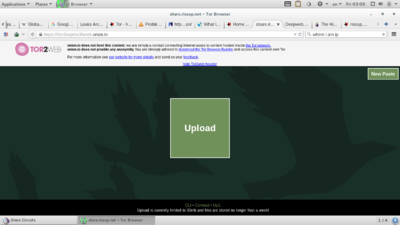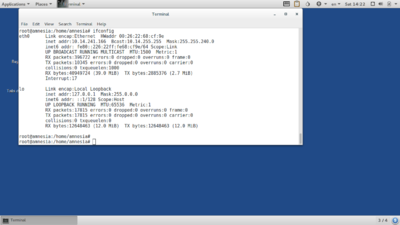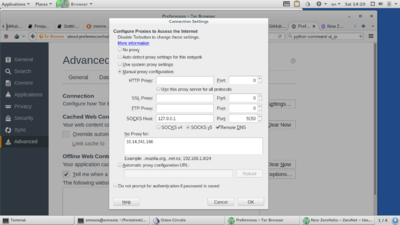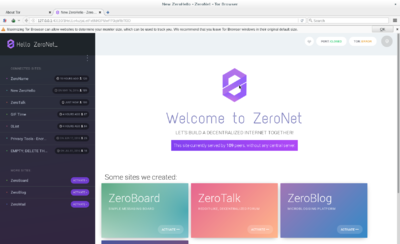Difference between revisions of "Deep web"
From Gender and Tech Resources
(Created page with "== What is the deep web??== The deep web refers to all the information that is in the world wide we but is not indexed so it is not possible to access it using search engines...") |
(No difference)
|
Revision as of 15:10, 1 February 2017
Contents
What is the deep web??
The deep web refers to all the information that is in the world wide we but is not indexed so it is not possible to access it using search engines like Google [1]. Web indexing (or Internet indexing) refers to various methods for indexing the contents of a website or of the Internet as a whole. Individual websites or intranets may use a back-of-the-book index, while search engines usually use keywords and metadata to provide a more useful vocabulary for Internet or onsite searching. With the increase in the number of periodicals that have articles online, web indexing is also becoming important for periodical websites [2]
According to the wikipedia "The portion of the web that is indexed by standard search engines is known as the surface web. As of 2001, the deep web was several orders of magnitude larger than the surface web. An analogy of an iceberg used by Denis Shestakov represents the division between surface web and deep web respectively: It is impossible to measure, and harsh to put estimates on, the size of the deep web because the majority of the information is hidden or locked inside databases. Early estimates suggested that the deep web is 400 to 550 times larger than the surface web. However, since more information and sites are always being added, it can be assumed that the deep web is growing exponentially at a rate that cannot be quantified.”
A common confusions is to mix up the deep web and the dark web. Latter corresponds to a part of the deep web, which besides not being indexed has been hidden using methods such as masking IP and/or requiring special permissions or the use of specific software to access it [3].
But if it is not indexed, how do we access it? Below we describe two ways you can immerse yourself in the deep web.
One of the easiest ways is to use the hidden service protocol TOR [4] that operates within the anonymous distributed network of TOR [5].
Considering the wide variety of users and type of information that you can find inside the deep web, it is initially easier and safer to access it using the TOR browser Cite error: Closing </ref> missing for <ref> tag.
Maybe you can ask yourself if it is not indexed where to start?
Case A
You get an .onion address. Those are “.onion is a special-use top level domain suffix designating an anonymous hidden service reachable via the Tor network. Such addresses are not actual DNS names, and the .onion TLD is not in the Internet DNS root, but with the appropriate proxy software installed, Internet programs such as web browsers can access sites with .onion addresses by sending the request through the network of Tor servers. The purpose of using such a system is to make both the information provider and the person accessing the information more difficult to trace, whether by one another, by an intermediate network host, or by an outsider [6].
For instance, you receive:
http://duskgytldkxiuqc6.onion
you need to change the .onion for something like:
.onion.to
.onion.city
.onion.cab
or any other domain made available by the network of volunteers of TOR2web [7].
and you need to open it up in the browser TOR.
Case B
You want to look for a page.
You can begin in: http://deepweb.pw/
This page could be opened in any browser but only using TOR browser you will be able to access .onion pages.
There you can find interesting sites like the Hidden wiki.
You can also look for information here:
https://ahmia.fi/search/
Or if you are interested in websites about leaks:
https://en.wikipedia.org/wiki/GlobaLeaks#Implementations
Other possible search places:
http://3g2upl4pq6kufc4m.onion/
https://www.reddit.com//r/onions
You should consider that the availability of information in many cases is temporary, so you will need to spend considerable time to get used to the deep web and search more fruitfully. Also the language can be a limitation and before entering forums remember that they generally use specific jargon[8].
Case C
You can also use the hidden services of Riseup
https://help.riseup.net/en/tor
Adding data to the deep web
Well now you surf the web deep but how do you add information?
If you need to add a file you can use the services Share of Riseup that let you upload a file up to 50mb for no more than a week. You can find the .onion.to league at: https://help.riseup.net/en/tor
The second option is using zeronet.io. This tool allows you to publish open, free and uncensored blogs and it uses the Bitcoin cryptography and the BitTorrent network.
Si bien puedes hacer uso de esta herramienta en diferentes sistemas operativos la opción que recomendamos es zeronet + TAILS (https://tails.boum.org/) debido a que representa la forma más segura, sin embargo requiere que dediques un poco más de tiempo a su configuración ya que debes saber habilitar puertos en el modem de internet.
¿Qué necesitas?
Una USB con TAILS que tenga persistencia
Habilitar el puerto 15441 en tu modem
¿Cómo se hace?
1) Ingresas a una sesión de TAILS usando persistencia y configuraciones avanzadas para poder acceder a la terminal root.
2) Desde una Terminal tienes que escribir:
Para actualizar e instalar las dependencias necesarias:
$ sudo apt-get update $ sudo apt-get upgrade $ sudo apt-get install python-msgpack python-gevent
Para descargar zeronet:
$ wget https://github.com/HelloZeroNet/ZeroNet/archive/master.tar.gz
Para descomprimir el archivo descargado:
$ tar xvpfz master.tar.gz
Para entrar en el archivo:
$ cd ZeroNet-master
Para iniciar
$ python zeronet.py
Si esta opción no te resulta necesitas:
Consultar tu ip
$ sudo ifconfig
Este comando te indicará cual es tu dirección de internet (inet addr), por ejemplo en la imagen es 10.14.241.166
$ python zeronet.py --proxy 127.0.0.1:9050 --tor disable --ui_ip inet_addr
En el comando anterior debes sustituir inet_addr con el que le corresponde a tu computadora
Con esto habrás iniciado los servicios de zeronet
3) En el navegador TOR tienes que abrir las opciones de Configuración y dirigirte a Avanzado ahí encontrarás la pestaña Redes (Network) y en el primer punto Conexión debes ir a Opciones y añadir en No proxi a 127.0.0.1 o a tu inet_addr
Después ya puedes abrir:
http://inet_addr:43110/
por ejemplo
http://127.0.0.1:43110
y encontrarás la interfase gráfica
Para crear un nuevo blog sólo debes activar Zero blog y usar la herramienta clonar.
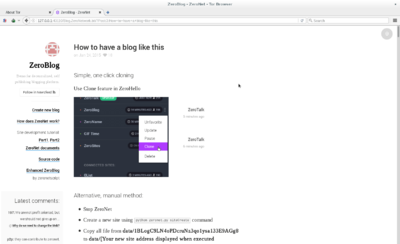
Nota:
Sólo podrás subir información a la red de zeronet si tienes habilitado el puerto 15441 Puedes ver más detalles sobre la configuración en ZeroNet
Referencias
- ↑ https://en.wikipedia.org/wiki/Deep_web
- ↑ https://en.wikipedia.org/wiki/Web_indexing
- ↑ https://en.wikipedia.org/wiki/Dark_web
- ↑ https://www.torproject.org/docs/hidden-services.html.en
- ↑ https://www.torproject.org/about/overview.html.en#thesolution
- ↑ https://en.wikipedia.org/wiki/.onion
- ↑ https://tor2web.org/
- ↑ http://domekit.cc/survival-kit-in-the-deep-web/



